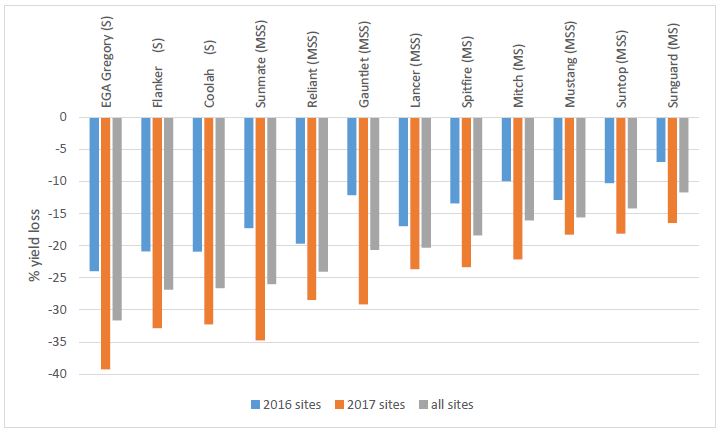|
Using tolerance as a crown rot management tool
Australia
June 8, 2018
- NVT disease rating data for crown rot focuses on the extent of basal browning associated with crown rot infection. This represents a rating for resistance.
- Suntop wheat has demonstrated an ability to maintain yield above its rating of MSS in comparison with other similarly rated varieties. This indicated an elevated level of tolerance.
Why do the trial?
Crown rot, caused predominantly by the fungus Fusarium pseudograminearum, remains the major biological constraint to the production of winter cereals in Queensland and northern New South Wales. New varieties are rated for their resistance to crown rot, but generally not for their tolerance. Although resistance (the ability of the plant to stop the crown rot fungus multiplying) is important, tolerance (the ability of the plant to yield in the presence of crown rot) has greater immediate economic impact. Consequently, since 2013, NSW DPI (with investment from GRDC) has been conducting a series of trials throughout the northern region to evaluate wheat varieties for their ability to maintain yield in the presence of high levels of crown rot inoculum. By assessing yield loss through the application of crown rot inoculum, a level of tolerance can be determined. This tolerance can be compared with the resistance ratings supplied by NVT to determine a variety’s overall ability to cope with, and control, high disease levels.
What happened?
Generally, varieties with higher resistance ratings demonstrated a greater tolerance to crown rot (ie. less yield loss). However, there was substantial variation in tolerance within the resistance classes (Figure 1). The percentage yield loss in the presence of elevated crown rot inoculum of the MSS rated varieties varied from 14% for Suntop to 26% for Sunmate. It is important to note that Suntop (although rated MSS) demonstrated a level of crown rot tolerance that is similar to the more tolerant varieties with an MS resistance rating.

Figure 1. Crown rot management trials 2016-2017. Percentage yield loss. (Only sites with significant (P=0.05) yield loss from crown rot inoculation have been included. Resistance rating in brackets).
Source: GRDC project DAN00175
What does this mean?
When selecting a variety to manage crown rot, growers can now assess both resistance and tolerance. While growing varieties with more resistance should lead to lower stubble infection and consequently lower losses in subsequent years, varieties with tolerance can be selected to decrease the yield impact of planting into a stubble with high crown rot inoculum. When combined with soil surveys such as PredictaB, growers can use this knowledge as part of their crown rot management strategy. Suntop, a well-adapted, high yielding, APH quality variety with good foliar disease resistance root lesion nematode tolerance and resistance, has shown that it is one of the most crown rot tolerant wheats available for the northern region.
Acknowledgements
Trial data kindly supplied with permission by NSW DPI, through the GRDC project DAN00175.
For further information please contact:
Douglas Lush, Marketing Manager, Northern NSW/QLD: 0407 177 029
Meiqin Lu, Wheat Breeder: 0428 856 612
agtbreeding.com.au
Disclaimer: The information contained in this brochure is based on knowledge and understanding at the time of writing. Growers should be aware of the need to regularly consult with their advisors on local conditions and currency of information.
More news from: AGT - Australian Grain Technologies Ltd.
Website: http://www.agtbreeding.com.au Published: June 8, 2018 |
|
The news item on this page is copyright by the organization where it originated
Fair use notice |